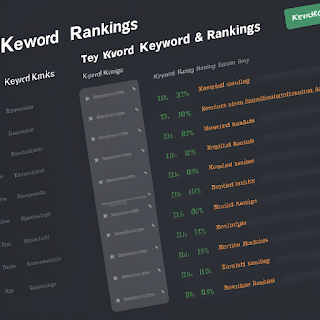the top best measurements of SEO to rank your site
preface
In today's digital landscape, search engine optimization (SEO) has
become an indispensable element for businesses and organizations of all sizes.
By optimizing their websites for search engines, businesses can improve their
online visibility, attract more website visitors, and ultimately boost their
bottom line.
However, with the ever-evolving nature of search engine algorithms and
the vast array of SEO metrics available, it can be challenging to determine
which measurements are most critical for achieving top rankings. In this
comprehensive guide, we will delve into the top best measurements of SEO to
rank your site, providing you with a clear understanding of the factors that
matter most for search engine success.
1. Organic Traffic
Organic traffic, also known as natural
traffic, refers to visitors who arrive at your website through unpaid search
engine results. This type of traffic is considered highly valuable as it
indicates that your website is relevant to the keywords users are searching
for.
To measure organic traffic, you can use
tools like Google Analytics, which provides detailed data on the number of
visitors coming to your site from organic search results. You can also track
your organic traffic over time to identify trends and assess the effectiveness
of your SEO efforts.
2. Keyword Rankings
Keyword rankings measure the position of
your website in search engine results pages (SERPs) for specific keywords.
Achieving high keyword rankings is crucial for organic traffic as it increases
the likelihood that your website will be seen by potential customers who are
searching for information or products related to your business.
You can track your keyword rankings
using tools like SEMrush or Ahrefs, which provide data on the exact position of
your website for a wide range of keywords. Regularly monitoring your keyword
rankings allows you to identify areas for improvement and make adjustments to
your SEO strategy accordingly.
3. Click-Through Rate (CTR)
Click-through rate (CTR) measures the
percentage of users who click on your website link when it appears in search
results. A high CTR indicates that your website titles and meta descriptions
are compelling and accurately reflect the content of your site.
To calculate CTR, divide the number of
clicks on your website link by the number of times your link is displayed in
search results. You can then compare your CTR to industry benchmarks to assess
your performance and identify areas for improvement.
4. Backlink Profile
Backlinks, also known as inbound links,
are links from other websites to your website. Backlinks are considered a vote
of confidence in the quality and authority of your website, and they play a
significant role in search engine rankings.
To evaluate your backlink profile, you can use tools like Moz or Ahrefs, which provide data on the number and quality of backlinks pointing to your website. You can also analyze the anchor text of your backlinks, which is the visible text that is hyperlinked to your site.
5. Domain Authority (DA)
Domain authority (DA) is a metric that
measures the overall strength and credibility of a website. It is calculated
based on a variety of factors, including the number and quality of backlinks,
website traffic, and social media engagement.
To track your DA, you can use tools like
Moz or Ahrefs. A higher DA typically indicates a more authoritative website,
which can lead to improved search engine rankings.
6. User Engagement Metrics
User engagement metrics, such as bounce rate, time on page, and pages
per session, provide insights into how visitors interact with your website.
These metrics can indicate whether your content is engaging and relevant to
your target audience.
You can measure user engagement metrics using tools like Google
Analytics. By analyzing these metrics, you can identify areas where your
website can be improved to provide a better user experience and boost SEO
performance.
7. Page Load Speed
Page load speed is a critical factor for both user experience and SEO.
A slow-loading website can frustrate visitors and lead to increased bounce
rates. Additionally, search engines tend to favor websites that load quickly.
You can measure your page load speed using tools like Google PageSpeed
Insights. By optimizing your website for faster loading times, you can improve
user experience and potentially enhance your search engine rankings.
8. Mobile Optimization
With the increasing prevalence of mobile internet usage, mobile optimization
has become a crucial aspect of SEO. A mobile-friendly website ensures a
seamless user experience for visitors accessing your site from their
smartphones or tablets.
To assess your website's mobile optimization, you can use tools like
Google's Mobile-Friendly Test. By optimizing your website for mobile devices,
you can cater to a wider audience and improve your overall SEO performance.
9. Technical SEO
Technical SEO refers to the optimization
of your website's technical structure and code to ensure that search engines
can easily understand and index your content. Technical SEO factors include
website structure, URL structure, sitemaps, robots.txt files, and schema
markup.
To sum up
This guide explores the importance of search engine optimization (SEO) for businesses, highlighting the various metrics available and the evolving nature of search engine algorithms. It provides a clear understanding of the factors crucial for achieving top rankings and improving online visibility.












.png)
.png)
